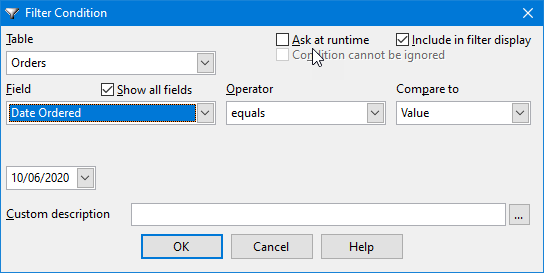Let's run the opportunity report you created in the previous tutorial. To do that, select it in the Reports Explorer and click the Preview button. It should look just as it did when you created it. However, what if we don't want every item printed? Say we only want items of a certain Stage. Restricting which records appear is called filtering. The Filtering page of the Reports Explorer is used for filtering, so select that page. Click the Filter button to display the Filter dialog. Currently, there are no filter conditions so the list of conditions shown in this dialog is blank. Click the Add button to add a condition to the list. The Filter Condition dialog shown below appears.

Since we want to filter on Stage, select Contact Opportunity from the Table list and Stage from the Field list. If you only want entries of a single stage, select "equals" from the Operator list. If you want all entries with one of several stages, choose "is one of". After selecting the operator, enter the desired Stage, then click the OK button. The Filter Condition dialog will disappear and your condition will appear in the Filter dialog. Although you can add other conditions, let's just click the OK button in the Filter dialog for now.
Now click the Preview button in the Reports Explorer. If there are any entries that match your conditions, the report displays only those entries. If there aren't any entries (for example, if you chose "Stage equals Initial Communication" and there aren't any entries of that stage), a message is displayed telling you that.
© Keystroke.ca, 2025 • Updated: 01/20/21
Comment or report problem with topic
 Lesson 2: Running a Report
Lesson 2: Running a Report